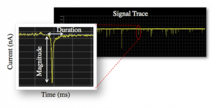Tunable resistive pulse sensing
Tunable Resistive Pulse Sensing (TRPS) is a technique that allows high-throughput single particle measurements as colloids and/or biomolecular analytes are driven through a size-tunable nanopore, one at a time.[1][2]
The technique adapts the principle of resistive pulse-sensing, which monitors current flow through an aperture, combined with the use of tunable nanopore technology, allowing the passage of ionic current and particles to be regulated by adjusting the pore size.[3][4]

Description
Particles crossing a pore are detected one at a time as a transient change in the ionic current flow, which is denoted as a blockade event with its amplitude denoted as the blockade magnitude. As blockade magnitude is proportional to particle size, accurate particle sizing can be achieved after calibration with a known standard.
Nanopore-based detection allows particle-by-particle assessment of complex mixtures. Optimization of pore size to particle size, by adjusting the stretch of the pore, can improve measurement accuracy.
Through combination with fine-control of pressure TRPS has been used to determine sample concentration [5][6] and to accurately derive particle electrophoretic mobility & surface charge[7] in addition to particle size information.
Applications
TRPS has been applied in product development by nanotechnology instrument manufacturers Izon Science Ltd in the first commercially available nanopore-based particle characterization systems.[8] These systems have been applied to measure a wide range of biological and synthetic particle types including viruses and nanoparticles. TRPS has been applied in both academic and industrial research fields, including:
- Drug delivery research
- Microvesicle and exosomes
- Virology and vaccine production
- Biomedical diagnostics
- Industrial research (e.g. paint & dye analysis)
- Microfluidics
References
- ↑ Dynamically resizable nanometre-scale apertures for molecular sensing"; Stephen J. Sowerby, Murray F. Broom, George B. Petersen; Sensors and Actuators B: Chemical Volume 123, Issue 1 (2007), pages 325-330
- ↑ Vogel et al. (2011) "Quantitative Sizing of Nano/Microparticles with a Tunable Elastomeric Pore Sensor" Journal of Analytical Chemistry 83 (9), pp 3499–3506
- ↑ Roberts et al. (2010) "Tunable Nano/Micropores for Particle Detection and Discrimination: Scanning Ion Occlusion Spectroscopy" Small - Volume 6, Issue 23, pp 2653–2658
- ↑ Willmott et al. (2010) "Use of tunable nanopore blockade rates to investigate colloidal dispersions" J. Phys.: Condens. Matter 22, 45411
- ↑ Willmott, G. R., Yu, S.S.C. and Vogel, R., “Pressure Dependence of Particle Transport Through Resizable Nanopores” Proceedings of ICONN, 128-131 (2010).
- ↑ G. Seth Roberts, Sam Yu, Qinglu Zeng, Leslie C.L. Chan, Will Anderson, Aaron H. Colby, Mark W. Grinstaff, Steven Reid, Robert Vogel. “Tunable Pores for Measuring Concentrations of Synthetic and Biological Nanoparticle Dispersions” Biosensors and Bioelectronics, 31 pp. 17-25, (2012).
- ↑ "A variable pressure method for characterising nanoparticle surface charge using pore sensors" Robert Vogel, Will Anderson, James Eldridge, Ben Glossop, and Geoff Willmott. Anal. Chem., Just Accepted Manuscript DOI: 10.1021/ac2030915 Publication Date (Web): February 27 (2012).
- ↑ "IZON launch world's first commercial nanopore platform". PRLog. June 23, 2009.